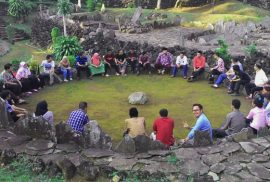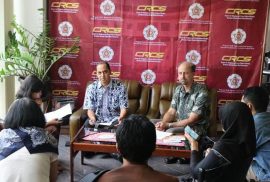Ali Jafar | CRCS | Wednesday Forum Report
 The discourse about “religion” “and” “science” has been long contested among scholars. Since the nineteenth century, religion and science have often been understood as in conflict with each other, science is human method for understanding nature using reason and religion relies on divine revelation. From different starting point, both religion and science have difficulties in finding common ground. But, starting from Ian Barbour, in the 1950s, a new discourse about the contemporary field of religion and science has proposed that integration is possible. Starting from this question at the Wednesday forum of CRCS/ICRS on 9th September 2015 , Zainal Abidin Bagir called for both side to re thinking the relation between science and religion.
The discourse about “religion” “and” “science” has been long contested among scholars. Since the nineteenth century, religion and science have often been understood as in conflict with each other, science is human method for understanding nature using reason and religion relies on divine revelation. From different starting point, both religion and science have difficulties in finding common ground. But, starting from Ian Barbour, in the 1950s, a new discourse about the contemporary field of religion and science has proposed that integration is possible. Starting from this question at the Wednesday forum of CRCS/ICRS on 9th September 2015 , Zainal Abidin Bagir called for both side to re thinking the relation between science and religion.
Bagir described the Barbourian discourse as sympathetic to religion, accepting of the basic theories and findings of modern science, and looking at scientists’ theories and theological beliefs to understand the relationship and its impact of the former on the latter. Barbour proposed a typology: conflict, independence, dialog- integration. In the conflict relation, we have to choose one. In the independent relation religion and science belong to separate world without contact. While in the dialog, we have to find similarities of them. The last is integration meaning that religion validate science each other.
Bagir explained that the territory struggle between religion and science outside the West is not about the content itself, but it is as part of resistance to colonialism. Among this contestation, bagir told about Islamic modernist movements. In Indian subcontinent there is Sayyed Ahmed Khan who integrated religious belief with modern science. Other example include Muhammad Abduh from Egypt, Muhammad Iqbal from Pakistan, and Hossein Nasr from Iran and so on, who were communicating religious belief with scientific ideas.
Indeed, Bagir argued that discussion of the discourse on the relation between religion and science should involve historical awareness. Moreover, it should not be just discussion of the content of the two fields but rather and examination of instrumental and social ethics, as well as epistemological and metaphysical view points. Bagir also noted that there are differences in the discourse between cultures and religious tradition. One example is that evolution is not a topic of debate in the Islamic world as in the United States.
Bagir discussed several instances of the “religion and science” discourse in Indonesia. For example, this question has arisen in relation to the educational models of Islamic Universities. When some of the IAINs (State Islamic Religious Institute) were transformed into UINs (State Islamic Universities), these new universities included faculties of natural and social science and medicine. Each university took its own approach to the question, but all tried to integrate the spirit of religion and the spirit of science.
Bagir also explained that the relation between religion and science at times of disaster can be one of competing authorities. He took an example from Merapi volcano eruption in 2010, when there was debate between scientific explanation and defiance by Mbah Maridjan, the traditional spiritual guidance of the volcano, though Bagir argued that the central was issue trust, not science versus superstition. Anticipating next week’s presentation by Samsul Maarif on the forestry practice of the indigenous people of Sulawesi, Bagir argued that the “religion” part of “religion and science” must be radically questioned and opened up to include indigenous religion which are often the same as indigenous ways of knowing nature, i.e. indigenous science. Moreover we must ask what this discourse is for: it is to dominate the other or it is for the well-being of all, including non-human communities.
Responding a question about scriptural authority in relation to scientific knowledge, Bagir answered both are known through interpretation. Another question is from Fahrur, a CRCS student, who asked about Bagir opinion on the integration of religious studies and science and other field of study, including English, at UIN Yogyakarta. Bagir described the integration is still among debate. If the purpose of integration is to create Islamic identity, what makes a field of study become Islamic? He took examples from UIN Jakarta and UIN Malang. At UIN Jakarta, there is no integrated study. Science and Islamic studies each follow its own logic and methods. While in UIN Malang, student in all field are prepared for their studies by learning about Islam for one year in a boarding school that is part of the university. Still, the science learned in university is not integrated with religious science.
Concluding the discussion, Bagir explained that the discourse of religion and science is still debatable among scholar. There are many discourses and opinions of integration of religious and science. Thus, he insisted Dr. Samsul Maarif to be speaker in the next Wednesday Forum to explain indigenous science and religion. Dr Samsul Maarif has taken his research in Amatoan in which the indigenous sciences of Amaatoan about forest conservation are coherent with their religious belief. (Editor: Greg Vanderbilt)
Zainal Abidin Bagir
Fardan Mahmudatul Imamah | CRCS | SPK

Jawa Barat adalah provinsi dengan kasus intoleran tertinggi di Indonesia, khususnya selama delapan tahun terakhir. Kasus intoleran tersebut berupa kekerasan terhadap kelompok minoritas seperti Ahmadiyah dan Syiah, penutupan gereja, kampanye anti perbedaan, peraturan daerah yang diskriminatif, serta pelanggaran hak-hak sipil. Hal ini terungkap pada salah satu sesi diskusi acara Sekolah Pengelolaan Keragaman (SPK), Selasa, 24 November 2015. Acara rutin tahunan hasil dari kerja sama Program Studi Lintas Agama dan Budaya (CRCS) UGM dengan Hivos tersebut dihadiri oleh dua puluh enam orang aktivis dan akademisi dari berbagai institusi pendidikan maupun lembaga sosial kemasyarakatan yang berada di Jawa Barat, seperti Fahmina Institut, Gerakan Islam Cinta, Jaringan Kerja Sama antar Umat Beragama (Jakatarub), Values Institut Bandung, Pelita Perdamaian, Peace Generation Indonesa, IPNU, Majelis Khuddamul Ahmadiyah Tasikmalaya, dan Sunda Wiwitan.
 Setelah Reformasi 1998, dalam situasi transisi menuju demokrasi, Indonesia dikejutkan dengan makin maraknya konflik-konflik bernuansa agama dan etnis, dan beberapa di antaranya hingga memakan korban jiwa dalam hitungan ribuan. Demokrasi membuka saluran yang tersumbat selama beberapa dasawarsa sebelumnya, dan ternyata tidak otomatis membawa pada kedamaian dan kesejahteraan. Identitas agama dan etnis, khususnya, menjadi bahasa utama untuk membolisiasi massa. Apa yang pada periode Orde Baru diasumsikan sebagai “kerukunan”, sebagai ciri yang dibanggakan Indonesia sebagai masyarakat majemuk, ternyata tampak hanya seperti bangunan yang rapuh. Dan yang lebih penting, ternyata kita tampaknya belum sepenuhnya memahami kemajemukan Indonesia dan bagaimana mengelolanya.
Setelah Reformasi 1998, dalam situasi transisi menuju demokrasi, Indonesia dikejutkan dengan makin maraknya konflik-konflik bernuansa agama dan etnis, dan beberapa di antaranya hingga memakan korban jiwa dalam hitungan ribuan. Demokrasi membuka saluran yang tersumbat selama beberapa dasawarsa sebelumnya, dan ternyata tidak otomatis membawa pada kedamaian dan kesejahteraan. Identitas agama dan etnis, khususnya, menjadi bahasa utama untuk membolisiasi massa. Apa yang pada periode Orde Baru diasumsikan sebagai “kerukunan”, sebagai ciri yang dibanggakan Indonesia sebagai masyarakat majemuk, ternyata tampak hanya seperti bangunan yang rapuh. Dan yang lebih penting, ternyata kita tampaknya belum sepenuhnya memahami kemajemukan Indonesia dan bagaimana mengelolanya.
Tolikara, Idul Fitri 2015: Tentang Konflik Agama, Mayoritas-Minoritas dan Perjuangan Tanah Damai
Tim Penulis CRCS – 19 Juli 2015
Suasana Idul Fitri di Kabupaten Tolikara, Papua terusik dengan berita kerusuhan yang menyebabkan satu orang meninggal dan belasan terluka karena tembakan aparat; serta puluhan kios dan sebuah musholla di dekatnya dibakar (menurut satu versi, musholla bukan target utama tapi ikut terbakar). Sejauh ini telah muncul berita dari beberapa sumber, yang sebagian tampaknya masih perlu diverifikasi. Namun, sebagian lain, sayangnya, dalam keterbatasan informasi yang ada kini, sudah “menggoreng” berita itu untuk melakukan provokasi lebih jauh, hingga ke tingkat menggiring isu ini menjadi konflik kekerasan antara Kristen dan Muslim—bukan hanya di Tolikara, tapi Papua, bahkan jangkauannya diperluas hingga Indonesia, mungkin juga ada yang memperluasnya untuk berbicara mengenai Muslim-Kristen di dunia!





